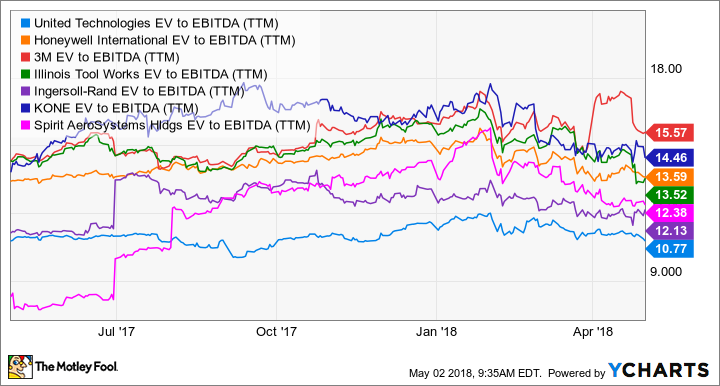Construction and aerospace company United Technologies Corporation (RTX 0.80%) is a good stock for investors willing to take a longer-view on matters. While the company's near-term earnings growth expectations are nothing to write home about, the company is positioning itself for strong long-term growth and management can take corporate action in order to generate value for investors. Let's take a closer look a why United Technologies is an attractive stock.
UTX EV to EBITDA (TTM) data by YCharts
The value pick in the multi-industrial sector
As you can see in the chart of EV to EBITDA above, United Technologies is the cheapest stock in its peer group, and it's worth noting that Finland's KONE and Ingersoll-Rand (TT 0.08%) are key competitors in elevators and heating, ventilation and air-conditioning (HVAC), respectively. Spirit AeroSystems also competes with UTC's Aerospace Systems (UTAS). Perhaps the reason for United Technologies valuation discount is that the market isn't attracted by analyst forecast for just 6.3% EPS growth for in 2018, not least because it comes after a year of flat EPS growth.
But here's the thing. EPS is forecast to grow by slightly more than 10% in 2019 and every one of the company's segments looks set to improve profitability in the future. Here are four reasons why the stock can rise.

United Technologies Corporation stock would suit a patient investor. Image source: Getty Images.
A break up could add value
First, CEO Greg Hayes has promised investors he was looking at strategic options that could be taken after the acquisition of Rockwell Collins (COL). As discussed previously, investors need to make a multitude of risk/reward calculations, across all four of its segments, before feeling fully comfortable buying the stock.
A break up would allow investors to make focused investments in the constituent parts. Speaking on the first-quarter earnings call, Hayes reiterated that he would defer discussions on the portfolio "until after the Collins transaction is completed mid-year" -- something to look out for. As you can see above the company's overall valuation is below that of competitors in each segment, suggesting the new companies could receive an individual rating higher than when they trade as part of United Technologies.
Climate, controls, and security segment
Second, the CCS segment looks set for strong growth in the coming years. As you can see below CCS (which contains HVAC company Carrier) and competitor Ingersoll-Rand (Trane) are both growing sale and orders at high rates. Granted CCS margin is coming under pressure from rising raw material costs (particularly steel) and Ingersoll-Rand is doing a better job on margin, but history shows that raw material prices are cyclical in nature and increases should moderate in the future.
In response to rising costs, Hayes said CCS had "additional price increases lined up for the rest of the year." This should help margins. Thinking longer-term, CFO Akhil Johri argued that the housing boom that started in 2000 means there will strong replacement demand for HVAC equipment in the coming years. He estimated the typical lifecycle for split air-conditioners is 15 to 18 years.

Data source: Company presentations. Chart by author.
Otis long-term service offering
Third, Otis has an opportunity to improve its service offering, not least on its own equipment in China -- the world's largest market for elevators. Moreover, management has been driving at increasing equipment market share in China, in order to benefit from more profitable long-term service revenue.
Unfortunately, the China elevator market is in decline. Although Otis has been winning back equipment market share, it's faced severe pricing pressure in an intensely competitive market characterized by multiple competitors. The good news is Johri suggested " price is stabilizing" in China, but the "bad news is that there is still negative pressure on the margin because the cost increases are greater than the price increases that we can get on the market."
Focusing on the longer-term, it appears that pricing conditions are stabilizing and if raw material price increases moderate then Otis could start to increase margin again. Hayes previously outlined that it would be a multi-year effort before the full benefits would be seen but Otis is on the right track.
Aerospace set to grow strongly
Fourth, the aviation-focused segments (Pratt & Whitney and United Aerospace Systems, or UTAS) had a good end to 2017 and momentum has been maintained in 2018. In-line with what Honeywell and General Electric reported, UTAS commercial aftermarket sales were strong with 16% organic growth in the first-quarter. In the long-term aftermarket sales should grow in-line with passenger traffic.
In addition, commercial original equipment (OE) sales are likely to pick up in the future. The current weakness is due to a raft of new aircraft programs pressuring sales on legacy aircraft.

Data source: United Technologies Corporation presentations. Chart by author.
Pratt & Whitney also reported strong commercial aftermarket sales (up 18% organically) and geared turbofan (GTF) production remains on track for 2018 -- Hayes noted that the GTF had seven years worth of backlog in place with "more than 9000 total firm option orders to date for the engine." The GTF -- one of the two engine options for the Airbus A320 neo -- and its long-stream of aftermarket and service revenue is the key to Pratt & Whitney's long-term profit generation.
A bright future for United Technologies
All told the best is yet to come for the company. Each of its segments has positive long-term prospects and even if the market doesn't wake up to the long-term prospects in terms of valuing the company in-line with its peers, then management could engineer a break up in order to create value for shareholders. It's an attractive investment, but it will require patience.






